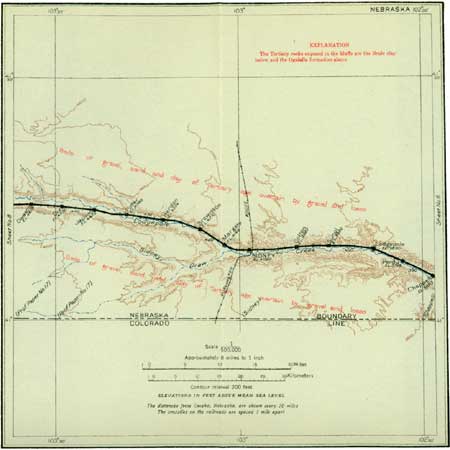
|
Geological Survey Bulletin 612
Guidebook of the Western United States: Part B |
ITINERARY

|
|
SHEET No. 7. (click on image for an enlargement in a new window) |
|
Sidney, Nebr. Elevation 4,090 feet. Population 1,185. Omaha 414 miles. |
Just before entering Sidney (see sheet 7, p. 36) the train passes under the tracks of a branch of the Chicago, Burlington & Quincy Railroad that runs from Denver to Alliance, in western Nebraska. The valley here is confined between bluffs composed at the top of an impure limestone, called "mortar beds." These bluffs are prominent near Sidney, where the rock is used as a building stone. It has furnished material for the depot and for many of the business blocks and public buildings in Sidney and neighboring towns. Were it not for the pebbles of harder rock that are embedded in it and make cutting difficult, it might be a valuable building stone. The "mortar beds" constitute the lower part of the Ogalalla formation and rest with uneven base on the Brule clay. Both these formations contain fossil bones of extinct mammals.1
1The fossils found in the Ogalalla formation show that western Nebraska was inhabited in late Miocene time by animals of very different types from those living there now, and also that very different physical conditions prevailed at that time. In place of the dry, barren plains of to-day there were numerous streams and swampy lowlands. The fossils of the Ogalalla and Arikaree formations are not greatly different and will be described together. Both these formations were spread out over a great plain, and it is not surprising to find in them the bones of plains or running animals, such as camels, horses, and deer, as well as of those that inhabited rivers, bayous, and marshes. Some of the horses were as large as small ponies and were more modern in appearance than their diminutive Oligocene and Eocene ancestors. They were also more numerous than their ancestors, and their fossil forms represent several widely different species.
The Arikaree contains great numbers of bones of a peculiar type of animals called chalicotheres. They were larger than a large horse and had a horselike head, long front legs, and shorter hind legs, but every foot had three toes, each of which in place of a hoof bore an enormous claw. One of the forms, known as Moropus (see Pl. VI, C, p. 40), was strangely grotesque. An equally strange form of Miocene time is a deerlike animal called Syndyoceras (see Pl VI, D), whose headdress equaled or outdid in grotesqueness that of its Oligocene ancestor Protoceras (see Pl. VII, E, p. 41). Its head somewhat resembled that of an antelope but was longer and had four horns, the larger pair, over the eyes, curving inward and the smaller pair, nearer the muzzle, curving outward. Although these are called horns, they were really bony protuberances and were probably not sheathed in real horn.

PLATE VI.—ROCKS OF MIOCENE AGE AND RESTORATIONS OF ANIMALS THAT LIVED IN NORTH AMERICA DURING THE MIOCENE EPOCH. A, SHORT-LIMBED RHINOCEROS, KNOWN AS TELECERAS, AN ANIMAL ABOUT 5 FEET HIGH (AFTER OSBORN); B, (a) MIOCENE MASTODON (TRILOPHODON PRODUCTUS) AND (b) PLEISTOCENE ELEPHANT (ELEPHAS IMPERATOR), AN ANIMAL NEARLY 15 FEET HIGH (AFTER OSBORN); C, MOROPUS ELASTUS, AN ANIMAL SOMEWHAT LARGER THAN THE MODERN HORSE (AFTER SCOTT); D, A FOUR-HORNED DEER (SYNDYOCERAS COOKI), ABOUT THE SIZE OF THE MODERN DEER (AFTER SCOTT); E, GIGANTIC GIRAFFE-CAMEL (ALTICAMELUS ALTUS), ABOUT 15 FEET HIGH (AFTER SCOTT); F, MIOCENE BEDS (ARIKAREE FORMATION) RESTING UNCONFORMABLY ON OLIGOCENE BEDS (BRULE CLAY) IN PAWNEE BUTTES, COLO. A-E published by permission The Macmillian Co. Camels were common in North America during the Miocene epoch, and several forms have been found. Those of one genus (Procamelus) were about the size of sheep and are supposed to be the ancestors of modern camels and llamas. Others were large and had long necks like the giraffe (see Pl. VI, E). All these ancient camels had hoofs like cattle, not cushioned feet like those of the camels of the present day.
Rhinoceroses were abundant in Miocene time. Hundreds of specimens of Teleoceras, a very heavy bodied, short-limbed type (see Pl. VI, A), have been found. The proboscidians, of which the elephant is the best-known type and the only living representative, became prominent during the Miocene epoch, when a large mastodon called Trilophodon was common.
Sidney came into prominence in 1868, when a military post was established here to protect emigrants and railroad builders from the Sioux and Pawnee Indians, the two powerful tribes of western Nebraska. This post was maintained until 1894. Sidney was the point from which freight was hauled to the Black Hills until that region was supplied from railroads running much nearer to it than the Union Pacific.
Beyond Sidney the trains pass several stations and small towns—Margate, Brownson, Hierdon, Potter, Jacinto, Dix, and Owasco (all shown on sheet 7)—before reaching Kimball (see sheet 8, p. 38).
| <<< Previous | <<< Contents >>> | Next >>> |
bul/612/sec9.htm
Last Updated: 28-Mar-2006